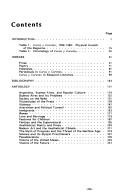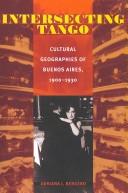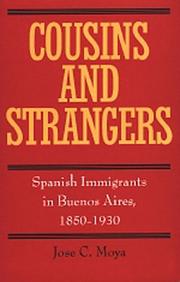| Listing 1 - 10 of 20 | << page >> |
Sort by
|

ISBN: 0879180633 Year: 1987 Publisher: Tempe Arizona state university. Center for Latin American studies
Abstract | Keywords | Export | Availability | Bookmark
 Loading...
Loading...Choose an application
- Reference Manager
- EndNote
- RefWorks (Direct export to RefWorks)
Buenos Aires (Argentina) --- -Civilization --- Caras y caretas (Buenos Aires, Argentina) --- Civilization. --- Caras y caretas (Buenos Aires, Argentina). --- Caras y caretas (Buenos Aires, Argentina. --- Trinidad del Puerto de Santa María de Buenos Aires (Argentina) --- Buenos Ayres (Argentina) --- Capital Federal (Argentina) --- Trinidad y Puerto de Santa María de los Buenos Aires (Argentina) --- Capital (Argentina) --- Ciudad Autónoma de Buenos Aires (Argentina) --- La Trinidad (Argentina) --- Trinidad (Argentina) --- gobBsAs (Argentina) --- Gobierno de la Ciudad Autónoma de Buenos Aires (Argentina) --- Buenos Aires (Federal Capital) --- CABA (Argentina) --- Autonomous City of Buenos Aires (Argentina) --- Buenos Ajres (Argentina)
Book
ISBN: 0814344569 0814344577 Year: 2018 Publisher: Wayne State University Press
Abstract | Keywords | Export | Availability | Bookmark
 Loading...
Loading...Choose an application
- Reference Manager
- EndNote
- RefWorks (Direct export to RefWorks)
Victor Mirelman, in his study of the greatest concentration of Latin American Jewry, examines the changing facade of the Argentinean Jewish community from the beginning of mass Jewish immigration in 1890 to its decline in 1930. During this period, Jews arrived from Russia, Poland, Romania, Syria, Turkey and Morocco Each group founded its own synagogues. mutual help organizations. hospitals. cultural associations. and newspapers of particular vitality was the Yiddish press and the Yiddish theatre. Jewish immigrants were also especially active politically. particularly in the Socialist Party and in the workers' unions. Based on research in the Argentine archives. Jewish Buenos Aires, 1890-1930 describes the immigration and settlement process. studies the first generation of Argentine-born Jews. and provides an understanding of assimilation and acculturation. Mirelman discusses the religious life of the community differentiating between the Ashkenazim and the various Sephardic groups and devotes chapters to Zionism, to Jewish culture in Yiddish. Hebrew. and Spanish. to education; and to social action Issues that created conflict and friction are analyzed in detail.
Jews --- History. --- Buenos Aires (Argentina) --- Ethnic relations. --- Hebrews --- Israelites --- Jewish people --- Jewry --- Judaic people --- Judaists --- Ethnology --- Religious adherents --- Semites --- Judaism --- Trinidad del Puerto de Santa María de Buenos Aires (Argentina) --- Buenos Ayres (Argentina) --- Capital Federal (Argentina) --- Trinidad y Puerto de Santa María de los Buenos Aires (Argentina) --- Capital (Argentina) --- Ciudad Autónoma de Buenos Aires (Argentina) --- La Trinidad (Argentina) --- Trinidad (Argentina) --- gobBsAs (Argentina) --- Gobierno de la Ciudad Autónoma de Buenos Aires (Argentina) --- Buenos Aires (Federal Capital) --- CABA (Argentina) --- Autonomous City of Buenos Aires (Argentina) --- Buenos Ajres (Argentina) --- Social groups: religious groups & communities
Book
ISBN: 1783203404 9781783203406 9781783203581 1783203587 Year: 2014 Publisher: Bristol Intellect Books
Abstract | Keywords | Export | Availability | Bookmark
 Loading...
Loading...Choose an application
- Reference Manager
- EndNote
- RefWorks (Direct export to RefWorks)
World Film Locations: Buenos Aires explores this picturesque and passionate city (the second-largest in South America) as a stage for sociopolitical transformations and a key location in the international imagination as a site of cultural export.
Motion picture locations --- Filming on location --- Locations (Motion pictures) --- Moving-picture locations --- Motion pictures --- Setting and scenery --- Buenos Aires (Argentina) --- Trinidad del Puerto de Santa María de Buenos Aires (Argentina) --- Buenos Ayres (Argentina) --- Capital Federal (Argentina) --- Trinidad y Puerto de Santa María de los Buenos Aires (Argentina) --- Capital (Argentina) --- Ciudad Autónoma de Buenos Aires (Argentina) --- La Trinidad (Argentina) --- Trinidad (Argentina) --- gobBsAs (Argentina) --- Gobierno de la Ciudad Autónoma de Buenos Aires (Argentina) --- Buenos Aires (Federal Capital) --- CABA (Argentina) --- Autonomous City of Buenos Aires (Argentina) --- Buenos Ajres (Argentina) --- In motion pictures.
Book
ISBN: 0739176315 9780739176313 9780739176306 0739176307 Year: 2014 Publisher: Lanham, Maryland
Abstract | Keywords | Export | Availability | Bookmark
 Loading...
Loading...Choose an application
- Reference Manager
- EndNote
- RefWorks (Direct export to RefWorks)
This book examines the conflicting performances that take place at the Holocaust Memorial in Berlin and the Memorial to the Victims of State Terror in Buenos Aires. Sion offers an interdisciplinary model for analyzing sites of memory, their purpose, failure and success, and their part in a transnational circuit of remembrance practices.
Holocaust memorials --- Holocaust, Jewish (1939-1945), and architecture. --- Architecture and tourism --- Tourism and architecture --- Tourism --- Architecture and the Holocaust --- Architecture --- Holocaust, Jewish (1939-1945) --- Memorials --- Berlin (Germany) --- Buenos Aires (Argentina) --- Trinidad del Puerto de Santa María de Buenos Aires (Argentina) --- Buenos Ayres (Argentina) --- Capital Federal (Argentina) --- Trinidad y Puerto de Santa María de los Buenos Aires (Argentina) --- Capital (Argentina) --- Ciudad Autónoma de Buenos Aires (Argentina) --- La Trinidad (Argentina) --- Trinidad (Argentina) --- gobBsAs (Argentina) --- Gobierno de la Ciudad Autónoma de Buenos Aires (Argentina) --- Buenos Aires (Federal Capital) --- CABA (Argentina) --- Autonomous City of Buenos Aires (Argentina) --- Buenos Ajres (Argentina) --- Buildings, structures, etc.
Book
ISBN: 1503604357 9781503604353 9781503601536 1503601536 Year: 2018 Publisher: Stanford, California
Abstract | Keywords | Export | Availability | Bookmark
 Loading...
Loading...Choose an application
- Reference Manager
- EndNote
- RefWorks (Direct export to RefWorks)
In the late nineteenth and early twentieth centuries, a massive wave of immigration transformed the cultural landscape of Argentina. Alongside other immigrants to Buenos Aires, German speakers strove to carve out a place for themselves as Argentines without fully relinquishing their German language and identity. Their story sheds light on how pluralistic societies take shape and how immigrants negotiate the terms of citizenship and belonging. Focusing on social welfare, education, religion, language, and the importance of children, Benjamin Bryce examines the formation of a distinct German-Argentine identity. Through a combination of cultural adaptation and a commitment to Protestant and Catholic religious affiliations, German speakers became stalwart Argentine citizens while maintaining connections to German culture. Even as Argentine nationalism intensified and the state called for a more culturally homogeneous citizenry, the leaders of Buenos Aires's German community advocated for a new, more pluralistic vision of Argentine citizenship by insisting that it was possible both to retain one's ethnic identity and be a good Argentine. Drawing parallels to other immigrant groups while closely analyzing the experiences of Argentines of German heritage, Bryce contributes new perspectives on the history of migration to Latin America—and on the complex interconnections between cultural pluralism and the emergence of national cultures.
Germans --- Ethnicity --- Nationalism --- Consciousness, National --- Identity, National --- National consciousness --- National identity --- International relations --- Patriotism --- Political science --- Autonomy and independence movements --- Internationalism --- Political messianism --- Ethnic identity --- Group identity --- Cultural fusion --- Multiculturalism --- Cultural pluralism --- Ethnology --- History. --- Buenos Aires (Argentina) --- Emigration and immigration --- Trinidad del Puerto de Santa María de Buenos Aires (Argentina) --- Buenos Ayres (Argentina) --- Capital Federal (Argentina) --- Trinidad y Puerto de Santa María de los Buenos Aires (Argentina) --- Capital (Argentina) --- Ciudad Autónoma de Buenos Aires (Argentina) --- La Trinidad (Argentina) --- Trinidad (Argentina) --- gobBsAs (Argentina) --- Gobierno de la Ciudad Autónoma de Buenos Aires (Argentina) --- Buenos Aires (Federal Capital) --- CABA (Argentina) --- Autonomous City of Buenos Aires (Argentina) --- Buenos Ajres (Argentina)
Book
ISBN: 1438473052 9781438473055 9781438473031 1438473036 1438473044 Year: 2018 Publisher: Albany
Abstract | Keywords | Export | Availability | Bookmark
 Loading...
Loading...Choose an application
- Reference Manager
- EndNote
- RefWorks (Direct export to RefWorks)
Argentina Noir offers a guide to Argentine crime fiction, with a focus on works published since the year 2000. It argues that the novela negra, or crime novel, has become the favored genre for many writers to address the social malaise brought about by changes linked to globalization and market-driven economic policies. Cynthia Schmidt-Cruz presents close readings and original interpretations of eleven novels, all set in or around Buenos Aires, and explores the ways these texts adapt major motifs, figures, and literary techniques in Hispanic crime fiction in order to give voice to wide-ranging social critiques. Schmidt-Cruz addresses such topics as organized crime and institutional complicity, corruption during the presidency of Carlos Menem (1989–1999), terrorist attacks on Jewish institutions in Buenos Aires and the mysterious death of Alberto Nisman, and the winners and the losers of neoliberal structural changes. With a solid underpinning in sociological studies and criticism of the genre and its historical context, Argentina Noir reveals how these novels are renovating the genre to engage pressing issues confronting not only Argentina but also countries throughout Latin America and around the globe.
Noir fiction, Argentine --- Argentine fiction --- Crime in literature. --- Argentine literature --- Argentine noir fiction --- History and criticism. --- Buenos Aires (Argentina) --- Trinidad del Puerto de Santa María de Buenos Aires (Argentina) --- Buenos Ayres (Argentina) --- Capital Federal (Argentina) --- Trinidad y Puerto de Santa María de los Buenos Aires (Argentina) --- Capital (Argentina) --- Ciudad Autónoma de Buenos Aires (Argentina) --- La Trinidad (Argentina) --- Trinidad (Argentina) --- gobBsAs (Argentina) --- Gobierno de la Ciudad Autónoma de Buenos Aires (Argentina) --- Buenos Aires (Federal Capital) --- CABA (Argentina) --- Autonomous City of Buenos Aires (Argentina) --- Buenos Ajres (Argentina) --- In literature.

ISBN: 0822959852 9780822959854 Year: 2008 Publisher: Pittsburgh: University of Pittsburgh Press,
Abstract | Keywords | Export | Availability | Bookmark
 Loading...
Loading...Choose an application
- Reference Manager
- EndNote
- RefWorks (Direct export to RefWorks)
Intersecting Tango engages Buenos Aires during the sweeping changes of 1900-1930, to capture a culture in motion through which Buenos Aires transformed itself into a modern, cosmopolitan city. Taking the reader through a dazzling array of sites, sources, and events, Bergero conveys the city in all its complexity. Drawing on architecture and gendered spaces, photography, newspaper columns, schoolbooks, “high” and “low” literature, private letters, advertising, fashion, and popular music, she illuminates a range of urban social geographies inhabited by the city's defining classes and groups. In mining this vast material, Bergero traces the profound change in social fabric by which these diverse identities evolved, through the processes of modernization and its many dislocations, into a new national identity capable of embodying modernity.
National characteristics, Argentine. --- Buenos Aires (Argentina) --- History --- Social conditions --- Argentine national characteristics --- Trinidad del Puerto de Santa María de Buenos Aires (Argentina) --- Buenos Ayres (Argentina) --- Capital Federal (Argentina) --- Trinidad y Puerto de Santa María de los Buenos Aires (Argentina) --- Capital (Argentina) --- Ciudad Autónoma de Buenos Aires (Argentina) --- La Trinidad (Argentina) --- Trinidad (Argentina) --- gobBsAs (Argentina) --- Gobierno de la Ciudad Autónoma de Buenos Aires (Argentina) --- Buenos Aires (Federal Capital) --- CABA (Argentina) --- Autonomous City of Buenos Aires (Argentina) --- Buenos Ajres (Argentina) --- National characteristics, Argentine --- Argentine --- Buenos Aires (Argentina) - History.
Book
ISBN: 9783110308228 9783110309539 311030953X 1306205417 9781306205412 3110308223 Year: 2013 Volume: 380 Publisher: Berlin De Gruyter
Abstract | Keywords | Export | Availability | Bookmark
 Loading...
Loading...Choose an application
- Reference Manager
- EndNote
- RefWorks (Direct export to RefWorks)
Communication between government authorities and immigrants is a topic of current relevance, posing difficulties for both sides. Drawing on 279 real conversations between immigrants and authorities in Berlin and Buenos Aires, this book discusses the causes of communication problems in an intercultural context and viable options for dealing with them. It is relevant for both research and practice.
Intercultural communication --- Germans --- German language --- History --- Buenos Aires (Argentina) --- Emigration and immigration --- Ashkenazic German language --- Hochdeutsch --- Judaeo-German language (German) --- Judendeutsch language --- Judeo-German language (German) --- Jüdisch-Deutsch language --- Jüdischdeutsch language --- Germanic languages --- Ethnology --- Cross-cultural communication --- Communication --- Culture --- Cross-cultural orientation --- Cultural competence --- Multilingual communication --- Technical assistance --- Anthropological aspects --- Trinidad del Puerto de Santa María de Buenos Aires (Argentina) --- Buenos Ayres (Argentina) --- Capital Federal (Argentina) --- Trinidad y Puerto de Santa María de los Buenos Aires (Argentina) --- Capital (Argentina) --- Ciudad Autónoma de Buenos Aires (Argentina) --- La Trinidad (Argentina) --- Trinidad (Argentina) --- gobBsAs (Argentina) --- Gobierno de la Ciudad Autónoma de Buenos Aires (Argentina) --- Buenos Aires (Federal Capital) --- CABA (Argentina) --- Autonomous City of Buenos Aires (Argentina) --- Buenos Ajres (Argentina) --- Intercultural communication - Buenos Aires (Argentina) --- Germans - Buenos Aires (Argentina) - History - 20th century --- German language - Buenos Aires (Argentina) - History - 20th century --- Buenos Aires (Argentina) - Emigration and immigration - History - 20th century --- Government Authorities. --- Intercultural Communication.
Book
ISBN: 9506021635 Year: 1999 Publisher: Buenos Aires Nueva Visión
Abstract | Keywords | Export | Availability | Bookmark
 Loading...
Loading...Choose an application
- Reference Manager
- EndNote
- RefWorks (Direct export to RefWorks)
Sociology of culture --- anno 1930-1939 --- anno 1920-1929 --- Buenos Aires --- Argentine literature --- Buenos Aires (Argentina) --- Argentina --- Buenos Aires (Argentine) --- Argentine --- Littérature argentine --- Literature and society --- Modernism (Literature) --- Crepuscolarismo --- Literary movements --- Postmodernism (Literature) --- Literature --- Literature and sociology --- Society and literature --- Sociology and literature --- Sociolinguistics --- Social aspects --- Trinidad del Puerto de Santa María de Buenos Aires (Argentina) --- Buenos Ayres (Argentina) --- Capital Federal (Argentina) --- Trinidad y Puerto de Santa María de los Buenos Aires (Argentina) --- Capital (Argentina) --- Ciudad Autónoma de Buenos Aires (Argentina) --- La Trinidad (Argentina) --- Trinidad (Argentina) --- gobBsAs (Argentina) --- Gobierno de la Ciudad Autónoma de Buenos Aires (Argentina) --- Buenos Aires (Federal Capital) --- CABA (Argentina) --- Autonomous City of Buenos Aires (Argentina) --- Buenos Ajres (Argentina) --- Intellectual life --- Intellectual life. --- Littérature et société --- Modernisme (Littérature) --- Social aspects. --- Aspect social --- Vie intellectuelle

ISBN: 0520921534 0585079137 9780520921535 9780585079134 9780520072299 0520072294 9780520215269 0520215265 0520072294 0520215265 Year: 1998 Publisher: Berkeley University of California Press
Abstract | Keywords | Export | Availability | Bookmark
 Loading...
Loading...Choose an application
- Reference Manager
- EndNote
- RefWorks (Direct export to RefWorks)
More than four million Spaniards came to the Western Hemisphere between the mid-nineteenth century and the Great Depression. Unlike that of most other Europeans, their major destination was Argentina, not the United States. Studies of these immigrants-mostly laborers and peasants-have been scarce in comparison with studies of other groups of smaller size and lesser influence. Presenting original research within a broad comparative framework, Jose C. Moya fills a considerable gap in our knowledge of immigration to Argentina, one of the world's primary "settler" societies. Moya moves deftly between micro- and macro-analysis to illuminate the immigration phenomenon. A wealth of primary sources culled from dozens of immigrant associations, national and village archives, and interviews with surviving participants in Argentina and Spain inform his discussion of the origins of Spanish immigration, residence patterns, community formation, labor, and cultural cognitive aspects of the immigration process. In addition, he provides valuable material on other immigrant groups in Argentina and gives a balanced critique of major issues in migration studies.
Spaniards --- Immigrants --- Social adjustment --- Adaptation, Social --- Adjustment, Social --- Social adaptation --- Deviant behavior --- Social psychology --- Social skills --- Spanish people --- Ethnology --- Emigrants --- Foreign-born population --- Foreign population --- Foreigners --- Migrants --- Persons --- Aliens --- History. --- Cultural assimilation --- Spain --- Argentina --- Buenos Aires (Argentina) --- Trinidad del Puerto de Santa María de Buenos Aires (Argentina) --- Buenos Ayres (Argentina) --- Capital Federal (Argentina) --- Trinidad y Puerto de Santa María de los Buenos Aires (Argentina) --- Capital (Argentina) --- Ciudad Autónoma de Buenos Aires (Argentina) --- La Trinidad (Argentina) --- Trinidad (Argentina) --- gobBsAs (Argentina) --- Gobierno de la Ciudad Autónoma de Buenos Aires (Argentina) --- Buenos Aires (Federal Capital) --- CABA (Argentina) --- Autonomous City of Buenos Aires (Argentina) --- Buenos Ajres (Argentina) --- Argenṭinah --- Argenṭine --- Argentine Confederation (1851-1861) --- Argentine Nation --- Argentine Republic --- Aruzenchin --- Confederación Argentina (1851-1861) --- Nación Argentina --- República Argentina --- アルゼンチン --- Provincias Unidas del Río de la Plata --- Emigration and immigration --- Ethnic relations.
| Listing 1 - 10 of 20 | << page >> |
Sort by
|

 Search
Search Feedback
Feedback About UniCat
About UniCat  Help
Help News
News